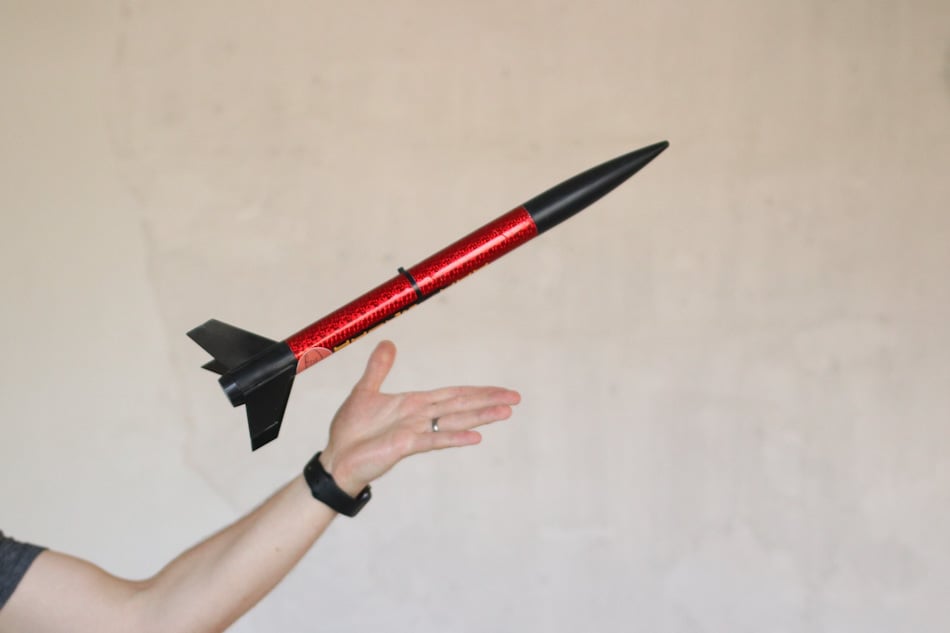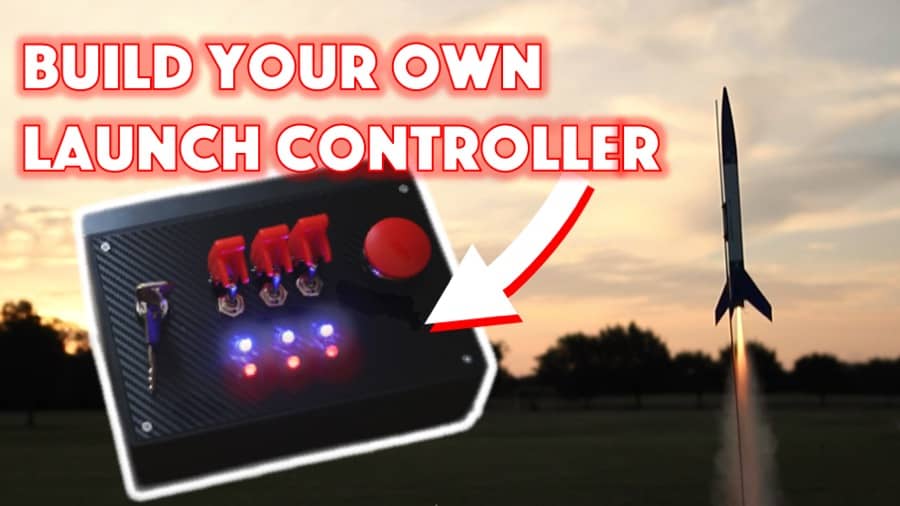
Spin stabilization is one of those topics that comes up as you get into making more advanced model rockets, and it is a fun stabilization method to experiment with. But what is model rocket spin stabilization, and is it worth it?
Spin stabilization works by spinning the rocket very rapidly in flight, creating a gyroscopic effect that resists outside forces that would alter its trajectory. In most cases, spin stabilization will not increase the effectiveness of the model rocket enough to warrant the disadvantages that come along with it.
If you’d like to know more about spin stabilization in model rockets and what the benefits of spin stabilization will cost you, continue reading. I break down how spin stabilization works, the benefits it offers, and the disadvantages it has below.
Are you still using the standard Estes controllers for your launches?
We just built our own beautiful launch controllers that make launches SO much more fun, and we documented EVERY single step and item purchased and put it into a step-by-step course that teaches you how to do the exact same thing.
Click here to learn more about how you can build your own launch controllers!

Model Rocket Stabilization
To say that having a stable rocket on the launching rod is very important is an understatement. Rocket stability is essential. As soon as an unstable rocket leaves the launch rod, it will fly erratically and unpredictably, creating a dangerous situation for yourself and any bystanders.
The stability of any rocket you design must be spot on in order for it to launch successfully and safely. Thankfully building a stable model rocket is not as difficult as the theory that goes into it.
How Model Rocket Stabilization Usually Works
In order to understand how spin stabilization works and to determine if it is a feature worth building into your rocket, you must first understand how model rocket stabilization normally occurs.
Normal model rocket stabilization is achieved by using fins and by putting the center of pressure behind the center of gravity.
Center of Pressure and Center of Gravity
The center of gravity is the average location of the weight of an object, but that doesn’t make a lot of sense to most folks. It is much easier to understand stand in practice. If you’ve ever balanced a ruler or a stick on your finger, then you’ve found the center gravity.
On a model rocket, you can find the center of gravity by balancing it on the edge of a ruler, your finger, or dangling it from a string.
The center of pressure is the average location where pressure is exerted. In a model rocket, it is where the forces of lift and drag will be exerted.
If your model rocket’s center of pressure is in front of the center of gravity, it will not stay that way for long! The rocket will attempt to fly backwards because the center of pressure always wants to be behind the center of gravity.
With the center of pressure behind the center of gravity, you will ensure that your rocket flies nose first, and you can also make use of fins.
You can find the center of pressure mathematically or by using a rocket simulator. Rocket simulators are very accurate at calculating the center of pressure. You could also just play around with the model rocket and test its stabilization using the method below.
Fins
Fins don’t just make the rocket look cool. They are the primary stabilization method used by most model rockets, and they are good at what they do.
If you launched a model rocket without fins, it would fly end over end through the air like in this video where a finless model rocket is tested repeatedly.
Fins allow a model rocket to self adjust using aerodynamic forces and this will keep the rocket stable and pointing in the right direction. You can see how this works in greater detail in this video which simulates how air interacts with the model rocket as it flies through the air.
Essentially, as the bottom of the rocket kicks out of alignment with the rest of the rocket, aerodynamic force will act upon the fin and cause it to shift back into place. This self correction keeps the rocket flying in a straight vertical line.
Testing Stabilization
Testing your if your model rocket is stable is easy. Attach a long and sturdy string or a rope to the model rocket at the center gravity. Then swing the string around your head like a lasso. It can help to record this so that you can observe how the rocket responds.
If the rocket flies straight, the stable. If the rocket does not fly straight, or if it dips up and down or oscillates at all, it is not stable. The center of pressure is not behind the center of gravity.
If the rocket flies backwards or fins first, but its flies straight, then the center of gravity and the center of pressure or probably too close or right on top of each other.
How Does Spin Stabilization Work?
Spin stabilization is when a model rocket is made to spin as it is launched through the air. This spinning motion can increase the stability of the model rocket.
Spin stabilization allows the rocket to fly in a straighter line because a spinning rocket will not react as quickly or as dramatically to aerodynamic disturbances as a non-spinning rocket will (source).
Spin stabilization is most commonly used in bullets and satellites or other things sent on a trajectory in space, but most modern rockets rely on more sophisticated solutions like a gimbaled thrust.
It is important to note that spin stabilization is not enough to keep the rocket on the straight and narrow. Spin stabilization is meant to enhance the stabilization provided through the normal method, not replace it.
In order for spin stabilization to replace a model rocket’s fins, it would have to be spinning extremely fast, in the hundreds if not thousands of revolutions per second.
That being said, carefully designed finless rockets are capable of launching successfully. Korey Kline reportedly did it in 1982 (source). The model rocket did not reach a very high altitude, but the flight was considered successful.
Korey Kline’s finless rocket did spin as it launched, but spin stabilization was not the sole stabilizing feature. The finless rocket used another form of stabilization called drag stabilization which uses the aerodynamic force of drag to stabilize the rocket, which is why it didn’t fly very high.
Just launching a model rocket with a spin will not be enough for it to launch without fins but adding a spin to a rocket has the potential to help keep the rocket straighter.
Disadvantages of Spin Stabilization
Spin stabilization is not a go to stabilization method among model rocket enthusiasts because it isn’t all that effective and spin stabilized rockets will not fly as high as a non-spinning rocket.
Slower Rocket
The first and most important reason that spin stabilization is not widely used to increase the stability of a model rocket is that is slows down the rocket during its flight.
Fin-spun model rockets, or rockets that use alterations to their fins to make the rocket spin, will not fly as high model rockets that do not use spin stabilization.
This is because to set the model rocket in a spin, it actually takes energy and that energy comes from the rocket’s kinetic energy or speed (source).
Additionally, the rocket will be slowed down because the spinning is caused by a lift force, which means there is also an increase in the drag force. Drag is a drag. It it will cause the model rocket to slow down.
A slow flying rocket will not be able to reach the same heights as a model rocket that isn’t spinning.
Parachute Problems
A rocket that is spinning when its parachute emerges could have a problematic landing. Parachute lines can quickly become twisted and tangled in such a way that the recovery system becomes ineffective.
A streamer would likely fare much better unless the rocket continues to spin as it descends, in which case the streamer would probably not flap back and for as much as it spins with the rocket. Streamers create drag by flapping back and forth. This is how the streamer slows down the rocket.
Plenty of rockets that spin during their flight land just fine, but the potential for the recovery system to fail is there. I’d stick with a streamer when experimenting with spin stabilization.
Spin Speed
It is very unlikely that a model rocket would be able to spin fast enough to make such a difference in the flight path that it offsets the other disadvantages of using spin stabilization. When a bullet, for example, is shot from a gun, it spins at thousands of revolutions per second to help it fly straight.
Now the accuracy that a bullet flies is clearly more important than the accuracy of a model rocket, but in order for spin stabilization to work optimally the model rocket would need to spin at a rate in the hundreds of revolutions per second if not more.
The Ideal
A model rocket is at its least stable just as it leaves the launch rod because it no longer has the rod’s guidance and it is still as a relatively low speed.
The ideal time to use spin stabilization would be early in the flight as the model rocket leaves the launch rod so that it can benefit from added stability when it is at its least stable.
Then, ideally, the spin would slow and stop so that the rocket can reach its top speeds without loss of energy or added drag.
Achieving this method is easier said than done, and for a rocket that it is already stable, it may seem like overkill.
The answer is a helical launch tower. NASA has used these to launch some of their rockets, but you can’t just go to the hobby shop and buy a helical launch tower. You would have to custom design one and build it yourself.
Of course, another way to add stability at launch is to use a slightly longer launch rod. This solution is much easier than building a helical launch tower
How to Experiment with Spin Stabilization
Just because spin stabilization is not the ideal way of creating stability in a rocket does not mean that it isn’t fun to experiment with. If you’re looking for a new model rocket feature to experiment with, spin stabilization could be it.
If you want to experiment with spin stabilization, there are some simple ways you can go about launching a rocket that spins all of which require that you modify your model rocket’s fins.
Messing with the fins of a model rocket can cause the rocket to react in an unpredictable way. While these modifications are not advanced level rocketry, this certainly isn’t beginner level stuff either. Make sure you launch carefully.
Spin tabs
Spin tabs are not usually something you add to a fin. It is a modification you make to the planned for fin. To make a spin tab, you alter the typical fin design so that a narrow portion of the bottom edge of the fin sits at an angle. The amount of angle you put on the fin is up to you, but it doesn’t need to be a lot. This is an area that would be fun to experiment with.
Whether you are custom designing a rocket or you are building from a box kit, the alteration is very similar.
All you need is a hobby knife, wood glue, and a protractor to ensure that the angle on all three fins are exact. It is imperative that each fin is exactly the same as the others.
If the fins are not identical, it could cause the rocket to cone. When a model rocket cones the nose of the rocket rotates in a wide circle and the bottom does not. This will obviously cause an unsuccessful launch.
Here is an easy to follow tutorial available on YouTube. It is by Tim Van Milligan of Apogee components. It is a little old, but still has solid information.
Canted Fins
Normally when affixing fins to a model rocket, you affix them so they sit vertically against the body tube. They stand just as straight as the rocket itself.
When you cant the fins, you affix them to the model rocket at a slight diagonal. You can increase the angle if you’re looking to experiment, but to induce a spin, it is not necessary.
The angle does not need to be huge for it to be effective. The larger the angle, the more drag the model rocket will experience, the slower it will go, the lower it will fly.
To cant the fins, all you need to do is draw a straight line where the fin should go. Put the top of the fin just outside of the top of the line, and the bottom of the fin just outside of the bottom line. Do this for all three fins. This should be enough to make your rocket spin.
Cambered Airfoil
An airfoil simply refers to the shape of the cross section of the fin. Most model rocket kits come with fins that are effective, but easy to manufacture. For top performing fins, it is always recommended that you airfoil, or shape the fins.
A symmetrical airfoil will not create a rotation in the rocket, but if you go with a cambered airfoil, it will cause the rocket to rotate. The cross section of a cambered airfoil looks like a teardrop shape, but one side of the teardrop is wider than the other.
To airfoil your model rocket’s fins all you need is a ruler, a pencil, and sandpaper on a block. It takes a lot of sanding! Here is a video of Tim Van Milligan again making a cambered wing for a model airplane to give you an idea of the process:
Rockets that Spin
There are a couple model rocket kits on the market today that spin when launched. These kits can be a great place to start if you’re just getting into spinning rockets.
The Estes Space Twister (link to check price on Amazon) is an intermediate level model rocket that uses a lip on the long edge of the fin to create a spinning effect. It can reach up to 900 miles high.
The Odd’l Rockets Pipeline is a tube fin rocket that spins! Tube fins are exactly what you might think. Instead of fin three small paper tubes are attached to the model rocket.
Additionally, if you can find them secondhand, these model rocket’s spin as well, and their designs may give you some inspiration for your own.
The Estes Spin Control is a spinning rocket that is equipped with a counter that will count how many times the rocket spins during its flight. How neat is that?
Lastly, the Estes Farside was a three-stage model with three sets of fins that sit off centered of each other.
The Takeaway
Spin stabilization is fun to experiment with, but it is not a practical stability solution. Many people look to spin stabilization to replace the fins in order to reduce drag on their model rocket, but finless flight is very difficult to achieve using spin stabilization alone.
Some might look to spin stabilization to keep their rocket flying straighter, and potentially higher, but this is also not the case as spin stabilization actually slows down the rocket.
If you’re looking for increased stability or less drag, there are more effective ways to achieve it.
Build Your Own Launch Controller
Don’t forget! You can ditch the stock controllers and confidently build your own from scratch using our step-by-step instructions and exact materials list! We promise this will make your launch experience 10x better, and using our course License to Launch you can be 100% confident you’ll be able to finish this project and be super proud of what you’ve built! Here’s a sneak peek below.
